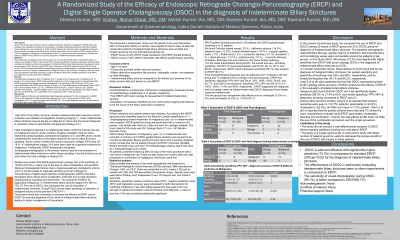Tuesday Poster Session
Category: Biliary/Pancreas
P2893 - A Randomized Study of the Efficacy of Endoscopic Retrograde Cholangiopancreatography (ERCP) and Digital Single Operator Cholangioscopy (DSOC) in the Diagnosis of Indeterminate Biliary Strictures
Tuesday, October 24, 2023
10:30 AM - 4:00 PM PT
Location: Exhibit Hall

Has Audio

Vishwa M. Dayal, MD, DM
Indira Gandhi Institute of Medical Sciences
Patna, Bihar, India
Presenting Author(s)
Dheeraj Kumar, MD, Vishwa Dayal, MD, DM, Ashish Jha, MD, DM, Sanjeev Jha, MD, DM, Ravikant Kumar, MD, DM
Indira Gandhi Institute of Medical Sciences, Patna, Bihar, India
Introduction: About 20% of the biliary strictures remains indeterminate after extensive investigations. ERCP with brush cytology is the standard technique for the evaluation of indeterminate biliary strictures. But ERCP-guided brush cytology has a low sensitivity of 15-60%. DSOC allows high resolution direct visualization of the bile duct and biopsy sampling under direct vision. Studies have shown that sensitivity of DSOC ranges from 66% to 72% for diagnosing malignant nature in indeterminate cases. The present study was conducted to compare the efficacy of ERCP versus DSOC for accurate diagnosis of indeterminate biliary strictures.
Methods: We conducted a randomized study over the period of one year (December 2021 to December 2022) in a tertiary care hospital of Bihar, India, wherein 60 consecutive patients of indeterminate biliary strictures were enrolled and divided randomly into two groups. Institutional Ethical Committee clearance and patient consent was obtained • ERCP Group (n=35): ERCP visual impression and ERCP-guided brushing • DSOC Group (n=25): DSOC impression with DSOC-guided biopsy sampling. Histopathologic or cytologic assessment was performed in terms of benign, indeterminate or malignant nature of the strictures. Procedural adverse events were documented. Sensitivity, Specificity, positive predictive value (PPV), negative predictive value (NPV) and diagnostic accuracy (DA) were calculated
Results: Final pathological diagnosis was 18 malignant and 17 benign in the first group and 15 malignant and 10 benign in the second group. ERCP diagnosed five malignant and four benign cases as indeterminate while DSOC diagnosed three benign cases as indeterminate. The sensitivity of DSOC biopsy (70.18%) was significantly higher than ERCP brush cytology (24.12%) (p< 0.02).
The differentiating visual findings during DSOC were tortuous dilated vessel ( 22.5 %) , Infiltrative stricture (16.5%) , polypoid mass (12.2%), nodular elevated lesion (9.6%) , irregular papillary lesion (11%). The sensitivity of visualisation was significantly better in DSOC (90.1%) over ERCP (60.7%) (p< 0.03). Side-effects were statistically similar in both the groups
Discussion: DSOC is safe and effective with higher diagnostic sensitivity (70.18%) in comparison to ERCP (24.12%) in the diagnosis of indeterminate biliary strictures (p< 0.02). The sensitivity of DSOC visual interpretation during ( 90.1 %) was also better than ERCP(60.7%). The overall diagnostic accuracy is also superior with DSOC (70%) over ERCP (50%) (p< 0.05)
Disclosures:
Dheeraj Kumar, MD, Vishwa Dayal, MD, DM, Ashish Jha, MD, DM, Sanjeev Jha, MD, DM, Ravikant Kumar, MD, DM. P2893 - A Randomized Study of the Efficacy of Endoscopic Retrograde Cholangiopancreatography (ERCP) and Digital Single Operator Cholangioscopy (DSOC) in the Diagnosis of Indeterminate Biliary Strictures, ACG 2023 Annual Scientific Meeting Abstracts. Vancouver, BC, Canada: American College of Gastroenterology.
Indira Gandhi Institute of Medical Sciences, Patna, Bihar, India
Introduction: About 20% of the biliary strictures remains indeterminate after extensive investigations. ERCP with brush cytology is the standard technique for the evaluation of indeterminate biliary strictures. But ERCP-guided brush cytology has a low sensitivity of 15-60%. DSOC allows high resolution direct visualization of the bile duct and biopsy sampling under direct vision. Studies have shown that sensitivity of DSOC ranges from 66% to 72% for diagnosing malignant nature in indeterminate cases. The present study was conducted to compare the efficacy of ERCP versus DSOC for accurate diagnosis of indeterminate biliary strictures.
Methods: We conducted a randomized study over the period of one year (December 2021 to December 2022) in a tertiary care hospital of Bihar, India, wherein 60 consecutive patients of indeterminate biliary strictures were enrolled and divided randomly into two groups. Institutional Ethical Committee clearance and patient consent was obtained • ERCP Group (n=35): ERCP visual impression and ERCP-guided brushing • DSOC Group (n=25): DSOC impression with DSOC-guided biopsy sampling. Histopathologic or cytologic assessment was performed in terms of benign, indeterminate or malignant nature of the strictures. Procedural adverse events were documented. Sensitivity, Specificity, positive predictive value (PPV), negative predictive value (NPV) and diagnostic accuracy (DA) were calculated
Results: Final pathological diagnosis was 18 malignant and 17 benign in the first group and 15 malignant and 10 benign in the second group. ERCP diagnosed five malignant and four benign cases as indeterminate while DSOC diagnosed three benign cases as indeterminate. The sensitivity of DSOC biopsy (70.18%) was significantly higher than ERCP brush cytology (24.12%) (p< 0.02).
The differentiating visual findings during DSOC were tortuous dilated vessel ( 22.5 %) , Infiltrative stricture (16.5%) , polypoid mass (12.2%), nodular elevated lesion (9.6%) , irregular papillary lesion (11%). The sensitivity of visualisation was significantly better in DSOC (90.1%) over ERCP (60.7%) (p< 0.03). Side-effects were statistically similar in both the groups
Discussion: DSOC is safe and effective with higher diagnostic sensitivity (70.18%) in comparison to ERCP (24.12%) in the diagnosis of indeterminate biliary strictures (p< 0.02). The sensitivity of DSOC visual interpretation during ( 90.1 %) was also better than ERCP(60.7%). The overall diagnostic accuracy is also superior with DSOC (70%) over ERCP (50%) (p< 0.05)
Disclosures:
Dheeraj Kumar indicated no relevant financial relationships.
Vishwa Dayal indicated no relevant financial relationships.
Ashish Jha indicated no relevant financial relationships.
Sanjeev Jha indicated no relevant financial relationships.
Ravikant Kumar indicated no relevant financial relationships.
Dheeraj Kumar, MD, Vishwa Dayal, MD, DM, Ashish Jha, MD, DM, Sanjeev Jha, MD, DM, Ravikant Kumar, MD, DM. P2893 - A Randomized Study of the Efficacy of Endoscopic Retrograde Cholangiopancreatography (ERCP) and Digital Single Operator Cholangioscopy (DSOC) in the Diagnosis of Indeterminate Biliary Strictures, ACG 2023 Annual Scientific Meeting Abstracts. Vancouver, BC, Canada: American College of Gastroenterology.
